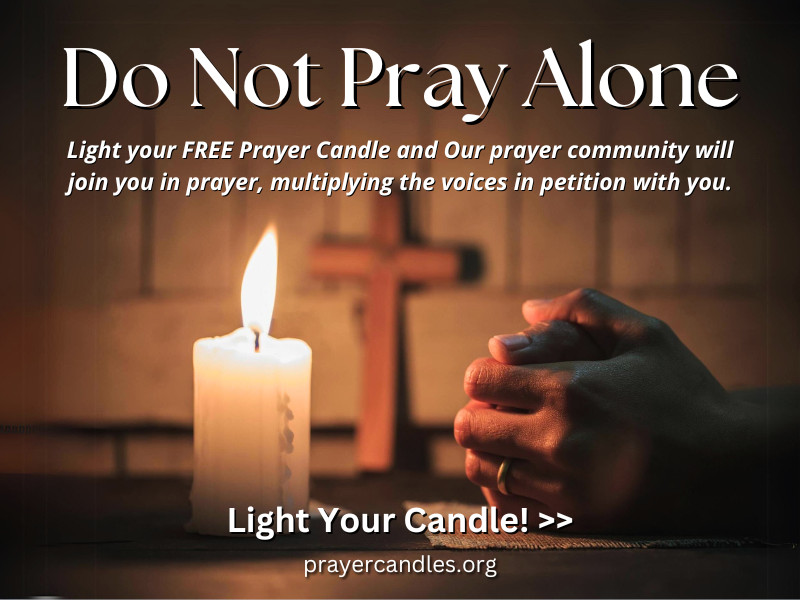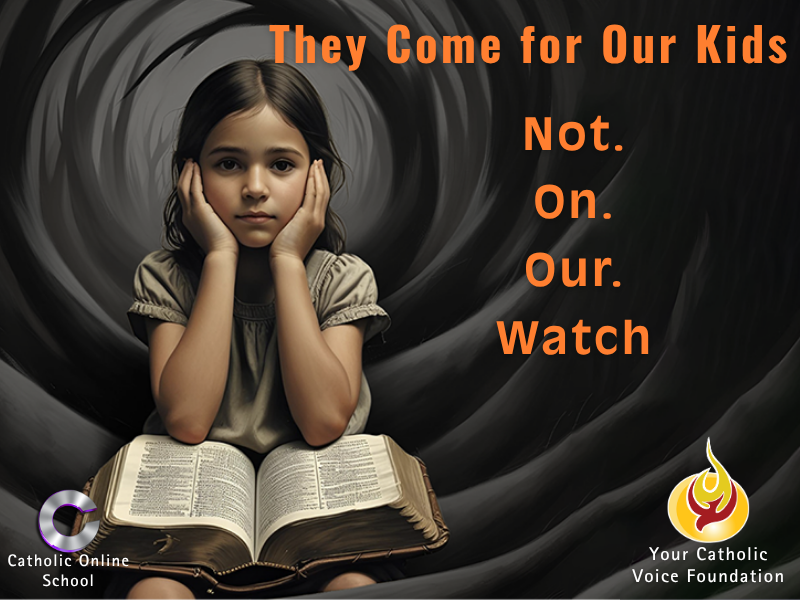 Dear readers, Catholic Online was de-platformed by Shopify for our pro-life beliefs. They shut down our Catholic Online, Catholic Online School, Prayer Candles, and Catholic Online Learning Resources essential faith tools serving over 1.4 million students and millions of families worldwide. Our founders, now in their 70's, just gave their entire life savings to protect this mission. But fewer than 2% of readers donate. If everyone gave just $5, the cost of a coffee, we could rebuild stronger and keep Catholic education free for all. Stand with us in faith. Thank you. Help Now >
Dear readers, Catholic Online was de-platformed by Shopify for our pro-life beliefs. They shut down our Catholic Online, Catholic Online School, Prayer Candles, and Catholic Online Learning Resources essential faith tools serving over 1.4 million students and millions of families worldwide. Our founders, now in their 70's, just gave their entire life savings to protect this mission. But fewer than 2% of readers donate. If everyone gave just $5, the cost of a coffee, we could rebuild stronger and keep Catholic education free for all. Stand with us in faith. Thank you. Help Now >
The one secret thing Californians are terrified of, but will never tell you about
FREE Catholic Classes
The elevated risk of the "Big One" in California has subsided, but that doesn't mean Californians should relax. The danger of a major quake in California remains real and experts agree, it is only a matter of time.
Highlights
CALIFORNIA NETWORK (https://www.youtube.com/c/californianetwork)
10/5/2016 (8 years ago)
Published in Green
Keywords: California, San Andreas Fault, earthquake, swarm, Salton Sea, fear, danger, warning
LOS ANGELES, CA (California Network) - For a seven-day period at the end of September and into October, Californians were reminded that earthquakes can be dangerous. The state is crisscrossed with deep, subterranean cracks known as fault lines. Pressure deep within the earth causes movement along these cracks which results in earthquakes.
Californians experience earthquakes all the time, at least one or two per year, in active places. They are short, and usually last only a few seconds. You don't feel the average earthquake, instead you hear it and see it, especially indoors. Walls creak, and everything begins to sway. The rattling of everything in your home is a little unnerving. Dogs start barking. By the time you realize there's an earthquake, a jolt arrives and the shaking intensifies. Then a second or few later, it just stops.
A quick survey of the home reveals everything in its place. Facebook posts begin along with the jokes, and somebody posts the official data for everyone to share. It dominates conversation for the rest of the day, then it's over. We Californians pat ourselves on the back for being courageous enough to live in a place where disasters strike without warning. Unlike the Midwest where they have tornadoes and the East coast where they have violent storms, we never get warnings, which gives us a bit of disaster swagger. Our disasters are better than yours because they happen without warning.
The California attitude is absurd, but it's very common. In the 1991 romantic comedy, "L.A. Story" by Steve Martin, the characters converse right through an earthquake then debate its relative strength as they dine on fine food; it's perfect satire.
Every Californian has a fear of parking garages and overpasses they do not tell outsiders about.
The California bravado masks a deep fear. Californians know the Big One is coming. The southern San Andreas fault, running up from Mexico though Los Angeles, has not had a major quake since 1680. Before that, the southern section averaged a major quake every 150 to 200 years. The fault is about 130 years overdue and all that pressure continues to build.
Scientists predict all that pent-up energy will be released in a single, major event that will rupture the ground for miles. The resulting quake will last for the better part of as minute, possibly longer. If it strikes near an urban area, buildings and bridges will collapse, retrofitted or not. Scientists predict it will strike with a minimum magnitude of 7 or greater.
For comparison, most people feel quakes around 2.5 and above, but the quakes don't do any damage until they exceed 5.5. Anything above a 6.0 is serious if it hits a populated area.
A 7.0 would release 32 times the amount of energy as a 6.0, using the moment magnitude scale for earthquakes. (The use of the Richter scale by the U.S. geological survey was discontinued in 2002.)
On any given day, the risk of the Big One happening is about 1 in 6,000, according to scientists. To appreciate the risk, imagine a bag that contains 5,999 black marbles and one red one. Each day one marble is drawn, then returned to the bag. It may happen on any day that the red marble is drawn, but the typical result is a black one. But sooner or later, luck will run out.
Starting on September 26, an earthquake swarm was detected miles underneath the Salton Sea. The Salton Sea is a man-made inland lake that sits below sea level in the southern Californian desert, northeast of San Diego. The lake is salty, the life around it has died, and it stinks of dead fish. The area was once a fashionable resort, decades ago, but now it is abandoned.
The area is also home to the southern stretch of the San Andreas Fault.
An earthquake swarm is a series of minor quakes concentrated in a small area. Scientists know from experience that major quakes can follow swarms, but not in every case.
The Salton Sea swarm caused scientists to issue a rare warning. The risk of a major quake -and not necessarily the Big One, had increased. The risk of the Big One was temporarily elevated to 1 in 500.
The swarm has since ended and the risk has returned to normal.
But talk of the Big One sharply increased and Californians did go out and prepare, particularly those in Southern California. Hardware stores reported an uptick in customers and survival stores and grocery stores reported people stocking up on camping and emergency supplies.
The state is also funding an early warning system that will warn people when they are about to feel a quake. 16(); -(?)5*8 The system, similar to ones used in Japan, detects the first waves of motion from a quake and sounds an alarm. The alarm will give people several seconds of warning, which is what people need to stop cars and trains, and to duck and cover. The system will be online within a few years.
In the meantime, Californians have gone back to life as usual. In Southern California it is finally fall, but summertime sunshine remains as it usually does, until November. The earthquake swarm is yesterday's news. So for now, it's back to the long-commutes and celebrity gossip, but none of us can drive over a high overpass or park in a subterranean garage without that pang of fear haunting us.
It's only a matter of time.
--- The California Network is the Next Wave in delivery of information and entertainment on pop culture, social trends, lifestyle, entertainment, news, politics and economics.
We are hyper-focused on one audience, YOU, the connected generation.
JOIN US AS WE REDEFINE AND REVOLUTIONIZE THE EVER-CHANGING MEDIA LANDSCAPE.
Join the Movement
When you sign up below, you don't just join an email list - you're joining an entire movement for Free world class Catholic education.
-

- Easter / Lent
- Ascension Day
- 7 Morning Prayers
- Mysteries of the Rosary
- Litany of the Bl. Virgin Mary
- Popular Saints
- Popular Prayers
- Female Saints
- Saint Feast Days by Month
- Stations of the Cross
- St. Francis of Assisi
- St. Michael the Archangel
- The Apostles' Creed
- Unfailing Prayer to St. Anthony
- Pray the Rosary
The Assumption of the Blessed Virgin Mary: A Sign of Our Eternal Hope
Mary’s ‘Magnificat’ Still Strengthens the Hope of the Faithful, Pope Leo Affirms
Mary, Our Icon of Hope, Leads Us to the Goal of Life
Daily Catholic
 Daily Readings for Saturday, August 16, 2025
Daily Readings for Saturday, August 16, 2025 St. Stephen the Great: Saint of the Day for Saturday, August 16, 2025
St. Stephen the Great: Saint of the Day for Saturday, August 16, 2025 Glory to God: Prayer of the Day for Saturday, August 16, 2025
Glory to God: Prayer of the Day for Saturday, August 16, 2025 Daily Readings for Friday, August 15, 2025
Daily Readings for Friday, August 15, 2025 St. Alipius: Saint of the Day for Friday, August 15, 2025
St. Alipius: Saint of the Day for Friday, August 15, 2025- Prayer to Our Lady, Assumed into Heaven: Prayer of the Day for Friday, August 15, 2025
![]()
Copyright 2025 Catholic Online. All materials contained on this site, whether written, audible or visual are the exclusive property of Catholic Online and are protected under U.S. and International copyright laws, © Copyright 2025 Catholic Online. Any unauthorized use, without prior written consent of Catholic Online is strictly forbidden and prohibited.
Catholic Online is a Project of Your Catholic Voice Foundation, a Not-for-Profit Corporation. Your Catholic Voice Foundation has been granted a recognition of tax exemption under Section 501(c)(3) of the Internal Revenue Code. Federal Tax Identification Number: 81-0596847. Your gift is tax-deductible as allowed by law.




 Daily Readings for Saturday, August 16, 2025
Daily Readings for Saturday, August 16, 2025 St. Stephen the Great: Saint of the Day for Saturday, August 16, 2025
St. Stephen the Great: Saint of the Day for Saturday, August 16, 2025 Glory to God: Prayer of the Day for Saturday, August 16, 2025
Glory to God: Prayer of the Day for Saturday, August 16, 2025 St. Alipius: Saint of the Day for Friday, August 15, 2025
St. Alipius: Saint of the Day for Friday, August 15, 2025

